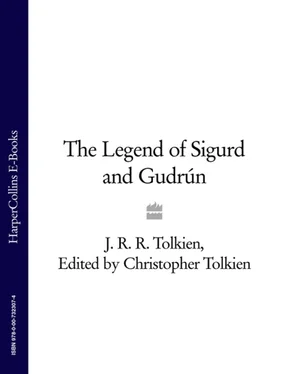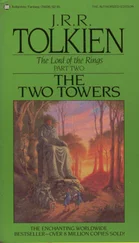J. Tolkien - The Legend of Sigurd and Gudrún
Здесь есть возможность читать онлайн «J. Tolkien - The Legend of Sigurd and Gudrún» — ознакомительный отрывок электронной книги совершенно бесплатно, а после прочтения отрывка купить полную версию. В некоторых случаях можно слушать аудио, скачать через торрент в формате fb2 и присутствует краткое содержание. Жанр: Старинная литература, на английском языке. Описание произведения, (предисловие) а так же отзывы посетителей доступны на портале библиотеки ЛибКат.
- Название:The Legend of Sigurd and Gudrún
- Автор:
- Жанр:
- Год:неизвестен
- ISBN:нет данных
- Рейтинг книги:5 / 5. Голосов: 1
-
Избранное:Добавить в избранное
- Отзывы:
-
Ваша оценка:
- 100
- 1
- 2
- 3
- 4
- 5
The Legend of Sigurd and Gudrún: краткое содержание, описание и аннотация
Предлагаем к чтению аннотацию, описание, краткое содержание или предисловие (зависит от того, что написал сам автор книги «The Legend of Sigurd and Gudrún»). Если вы не нашли необходимую информацию о книге — напишите в комментариях, мы постараемся отыскать её.
The Legend of Sigurd and Gudrún — читать онлайн ознакомительный отрывок
Ниже представлен текст книги, разбитый по страницам. Система сохранения места последней прочитанной страницы, позволяет с удобством читать онлайн бесплатно книгу «The Legend of Sigurd and Gudrún», без необходимости каждый раз заново искать на чём Вы остановились. Поставьте закладку, и сможете в любой момент перейти на страницу, на которой закончили чтение.
Интервал:
Закладка:
Iormunrek ( Jörmunrekkr ) was the Norse form of the name of Ermanaric, king of the Ostrogoths, the eastern branch of the Gothic people, who dwelt in the South Russian plains in the fourth century. The vast dominion of Ermanaric extended over many tribes and peoples from the Black Sea north towards the Baltic; but about the year 375, in his old age, he took his own life, in the face of the first overwhelming onset of the Asiatic steppe nomads, the Huns, who inspired widespread terror by their savagery and their appearance. To that distant time the song of Gunnar reached back, as did his minstrelsy at the feast held in honour of Sigurd in the halls of Gjúki (the Lay of the Völsungs, VII.14); the line ‘earth-shadowing king’ in the present stanza no doubt refers to the vastness of Ermanaric’s empire.
In the centuries that followed Ermanaric became a mighty figure in the heroic legends of Germanic-speaking peoples, his name darkened by the evil deeds that attached to his fame. In the few traces of Old English heroic legend that survive he was remembered as wrað wærloga, ‘fell and faithless’, and in the little poem called Deor he appears in these lines:
We geascodon Eormanrices
wylfenne geþoht: ahte wide folc
Gotena rices: þæt wæs grim cyning.
‘We have heard of the wolfish mind of Eormanric: far and wide he ruled the people of the realm of the Goths: he was a cruel king.’
The names in lines 5–8 are derived from The Battle of the Goths and the Huns, a very ancient and ruinous Norse poem embedded in Heiðreks Saga (also called Hervarar Saga ), which is to be seen as the bearer of remote memories of the first Hunnish attacks on the Goths, with ancient names preserved in a traditional poetry.
Of these names, Angantýr is a Gothic king; and Dúnheiðr , scene of a great battle, probably contains Norse Dúna, the Danube. ‘Danpar-banks’ in Gunnar’s earlier song (Lay of the Völsungs VII.14) and ‘Danpar’s walls’ in the present stanza derive from the Norse Danparstaðir, a survival of the Gothic name of the river Dnieper. Of its occurrence in Atlakviða my father noted in his lecture that it was ‘a reminiscence probably of Gothic power and splendour in the old days before Ermanaric’s downfall’.
87 Snævar is named in Atlamál as one of Högni’s sons (note to 59).
91 ‘ruth’: sorrow, regret.
93–112 This part of the narrative in the Lay is entirely independent of the Norse sources. Atli, being released, now sent for reinforcements (93), while the Niflungs held the doors of the hall (95) – and in this the German tradition of the legend appears, but strongly influenced by the Old English poetic fragment known as The Fight at Finnsburg (which is not in itself in any way connected with the Niflung legend). Beside stanzas 96–99 may be set the opening of The Fight at Finnsburg (translation by Alan Bliss, cited from J.R.R. Tolkien, Finn and Hengest, ed. Bliss, 1982, p.147):
‘... gables are burning.’
Hnæf spoke, the warlike young king: ‘Neither is this the dawn from the east, nor is a dragon flying here, nor are the gables aflame; nay, mortal enemies approach in ready armour. Birds are crying, wolf is yelping; spear clashes, shield answers shaft. Now that this moon shines, wandering behind the clouds, woeful deeds are beginning, that will bring to a bitter end this well-known enmity in the people. Awaken now, my warriors! Grasp your coats of mail, think of deeds of valour, bear yourselves proudly, be resolute!’
In the Lay the fighting is said to have lasted for five days (102); and in The Fight at Finnsburg the same is said.
It is interesting to see that in lecture notes on the Nibelungenlied my father wrote ‘compare Finnsburg’ against his reference to the scene when Hagen (Högni) and his mighty companion Volker the Minstrel guarded at night the doors of the sleeping-hall where the Burgundians were quartered, and saw in the darkness the gleam of helmets. So also he wrote of the Old English poem in Finn and Hengest (edition referred to above, p.27): ‘The Fragment opens with the “young king” espying an onset – like the helmets gleaming when the sleeping hall is attacked in the Nibelungenlied. ’
The German tradition is again present in the burning down of the hall in which the Niflungs were besieged. But in the Nibelungenlied, and in the thirteenth century Norwegian Thiðrekssaga based on North German tales and songs, this is altogether differently motivated, for it was Kriemhild (Gudrún in the Norse legend) who inspired the invitation to Hunland, in order to get vengeance on Gunther and Hagen (Gunnar and Högni) for the murder of Siegfried (Sigurd). It was Kriemhild who gave the order for the hall in which the Nibelungs slept to be set on fire; whereas in the Lay of Gudrún it is one Beiti, counsellor of Atli, who was the instigator of the burning (105). But the detail of the trapped warriors drinking blood from the corpses (109) is derived from the Nibelungenlied.
In Atlakviða Gudrún set the hall on fire at the end of the poem, after the murder of Atli and their children, and this appears at the end of the Lay of Gudrún (153).
105 The name Beiti is derived from Atlamál , where he is Atli’s steward (see note to 118–131).
112 ‘the Need of the Niflungs’. ‘Need’ is written with a capital because the phrase echoes the last words of the Nibelungenlied : ‘Here the story ends: this was der Nibelunge nôt. ’ The word nôt , which is in origin the same as English need , refers to the terrible extremity and end of the Nibelungs.
113–116 Atli’s treatment of the bound Gunnar before Gudrún’s eyes, while taunting her with the vengeance now achieved for Sigurd, is found neither in the Eddaic poems nor in the Völsunga Saga ; but it is the spring of Gudrún’s ‘ruthless hatred’ (133) and of her insanely savage action after her brothers have been killed: she makes her demand for her brothers’ lives (116) in the form ‘by Erp and Eitill our own children’ (and in 120 ‘by those born of us!’).
114 ‘Budlung’s vengeance’: the vengeance of Atli son of Budli.
118–131 In Atlakviða Gunnar, asked if would purchase his life with the gold, replied that ‘The heart of Högni must lie in my hand.’ They cut the heart from one ‘Hjalli the craven’ instead, and laid it before Gunnar, who knew that it was not Högni’s heart, because it quivered; but it is not in any way explained why they did this. Then they cut out Högni’s heart, and Gunnar knew that it was his, since it quivered scarcely at all. In Atlamál it is Atli who commanded the cutting out of Högni’s heart, but Beiti Atli’s steward suggested that they take Hjalli the cook and swineherd instead, and spare Högni; they seized the screaming Hjalli, but Högni interceded for him, saying that he could not endure the noise, and that he would ‘rather play out this game myself’. Then Hjalli was released, and Högni was killed, and there is no mention of the story of the two hearts.
In the Saga the two are rather crudely combined: Atli commands that Högni’s heart be cut out, a counsellor of Atli proposes the substitution of Hjalli, Högni intercedes for him; Atli then tells Gunnar that he can only purchase his life by revealing where the treasure lies, Gunnar replies that he must first see Högni’s heart, and so Hjalli is seized again and his heart cut out, and the rest of the story is as in Atlakviða.
In the Lay of Gudrún the sources are interwoven more skilfully: it is Gunnar who demands to see Högni’s heart, as in Atlakviða , but an explanation is provided (121) for the preliminary assault on Hjalli the swineherd: ‘wisemen bade him / wary counsel’ (they told Atli to beware), fearing the queen’s wrath. Högni does not inter-cede for Hjalli, but merely expresses his distaste for the shrieking; and the swineherd is given no respite.
Читать дальшеИнтервал:
Закладка:
Похожие книги на «The Legend of Sigurd and Gudrún»
Представляем Вашему вниманию похожие книги на «The Legend of Sigurd and Gudrún» списком для выбора. Мы отобрали схожую по названию и смыслу литературу в надежде предоставить читателям больше вариантов отыскать новые, интересные, ещё непрочитанные произведения.
Обсуждение, отзывы о книге «The Legend of Sigurd and Gudrún» и просто собственные мнения читателей. Оставьте ваши комментарии, напишите, что Вы думаете о произведении, его смысле или главных героях. Укажите что конкретно понравилось, а что нет, и почему Вы так считаете.












